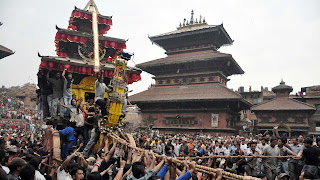Biska Jatra is an annual event in Bhaktapur, Dhapasi Thimi and Tokha and various places in Nepal. The festival is celebrated at the start of the new year on the Bikram Sambat calendar, however, the festival itself is not related to Bikram Sambat.
Legend has it that this celebration is the "festival after the death of the serpent". Numerous areas of Bhaktapur city celebrate this festival according to their own ritual. The most eventful places in the course of the festival are Bhaktapur Durbar Square and Thimi Balkumari. A huge chariot carrying a statue of the God Bhairava is pulled by hundreds of people to the Khalla Tole. Approximately a month earlier, the chariot is assembled near the Nyatapole temple (five stair temple). The most spectacular event on Bhaktapur Tamadhi is a huge tug-of-war between the Thane ( upper) and Kone (lower) part of town. Each team tries to pull to their side but later the chariot heads toward Khalla Tole. A huge approximately 25 meters Yoh si Dyo is erected in the yosi khyo In the evening of New Year, the Yoh si is pulled down as the New Year officially commences.
In Balkumari Thimi has very spectacular color festival (Sindur Jatra). Folks from various parts of Madhyapur Thimi gather, carrying their own chariots in Layeku Thimi. People celebrate and share greeting throwing simrik color powder, playing Dhimay music.
A place called Bode witnesses a tongue-piercing ceremony. One of a resident spend whole day with iron spike piercing in his tongue and roams different part of city by carrying multiple fire torch on shoulder. Juju Bhai Shrestha is the most renown and frequent tongue piercer in the town.
Legend has it that this celebration is the "festival after the death of the serpent". Numerous areas of Bhaktapur city celebrate this festival according to their own ritual. The most eventful places in the course of the festival are Bhaktapur Durbar Square and Thimi Balkumari. A huge chariot carrying a statue of the God Bhairava is pulled by hundreds of people to the Khalla Tole. Approximately a month earlier, the chariot is assembled near the Nyatapole temple (five stair temple). The most spectacular event on Bhaktapur Tamadhi is a huge tug-of-war between the Thane ( upper) and Kone (lower) part of town. Each team tries to pull to their side but later the chariot heads toward Khalla Tole. A huge approximately 25 meters Yoh si Dyo is erected in the yosi khyo In the evening of New Year, the Yoh si is pulled down as the New Year officially commences.
In Balkumari Thimi has very spectacular color festival (Sindur Jatra). Folks from various parts of Madhyapur Thimi gather, carrying their own chariots in Layeku Thimi. People celebrate and share greeting throwing simrik color powder, playing Dhimay music.
A place called Bode witnesses a tongue-piercing ceremony. One of a resident spend whole day with iron spike piercing in his tongue and roams different part of city by carrying multiple fire torch on shoulder. Juju Bhai Shrestha is the most renown and frequent tongue piercer in the town.

Comments
Post a Comment